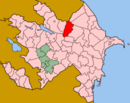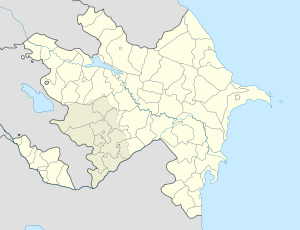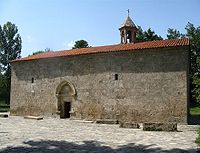- Nij, Azerbaijan
-
Nij — Municipality — Coordinates: 40°56′42″N 47°40′09″E / 40.945°N 47.66917°ECoordinates: 40°56′42″N 47°40′09″E / 40.945°N 47.66917°E Country  Azerbaijan
AzerbaijanRayon Qabala Population[citation needed] – Total 6,196 Time zone AZT (UTC+4) – Summer (DST) AZT (UTC+5) The town of Nij (also, Nidzh), located forty kilometers south west of Gabala in the Republic of Azerbaijan, is the only place in the world that has had a settlement of Udi people.[1] It has a population of 6,196.The forefathers of this ethnic minority, known as the Utis, were members of one of the twenty six Albanian tribes who played an important role in the creation of the State of Caucasian Albania, which is situated in Azerbaijan and in the southern territories of Daghestan (currently, the Russian Federation) in the IV-III Centuries B.C.[2]
According to the latest studies, ancient Udin (Albanian) was the language of Caucasian Albania.[3] The Uti Albanian tribe, the ancestor of the current Udins, has been described in the writings of Herodotus,[4] Strabo[5] and Pliny the Great.[6] According to these chroniclers, the Utis became politically active following their involvement in the military incursions into Greece of Persian Emperor Xerxes I.
Considering themselves as Albanians by origin, the Udins belonged to the Christian Monophysitism Movement. They are the only ethnic minority retaining their affiliation to Christianity in Azerbaijan. The Albanian-Udin Apostolic Autocephalous church is located in Nij. As an integral part of the Albanian Church, the Udin church is one of the most ancient churches of the Christian world.
The Udin language, one of the languages of the Caucasus, is the mother tongue of the Udin Tribe, and the Udins, living in Nij, are bilingual in both Azerbaijani and the Udin language.
During the V-IX Centuries, Christians in Caucasian Albania used the original Albanian written language. As a result of the later political weakening of the State of Caucasian Albania and the Albanian Catholicate, the Albanian script gradually faded out, and subsequently its usage was discontinued. Currently, the Udin Alphabet contains 52 symbols.
The first Udin school and then, subsequently, Russian rural school, was opened in Nij in 1854. Throughout 1931 to1933, the education of Udins was carried out in the Udin language, and from 1937, in Azerbaijani.
The settlement of Nij is a unique district, with its unusual planning lay out, transport systems, and its public, private and religious buildings. Nij is also a unique place, as various ethnic and religious groups co-existed throughout the centuries. The settlement of Nij is divided into several quarters, based on the family relationships of its residents. Practically all the names of these quarters are in Azerbaijani - such as Hajibayli, Darabag, Daramahla, Vazirli, Farimli, Malbel, Agdamekli, Melikli, Falshyly, Manjyly, Delekli, Chirmakhli and Abdally. This historic custom of naming the town’s different quarters again confirms the close historical and cultural ties between the Muslim population of Udins and the Azerbaijanis. Throughout the centuries, in this small district, there has been present the combined cultures and traditions of both the East and the West, and the North and the South, demonstrating that Azerbaijan has a thousand year history of both ethnic and religious toleration.
It should be noted that, despite the small number of Udins – presently 4,000 in Azerbaijan - and their long presence amongst the Muslim population of Azerbaijan, they sought to preserve their ceremonies, faith and economic traditions. Furthermore, the centuries’ long co-existence of the Udins with the various peoples of Azerbaijan, has caused the development amongst them of many shared economic and cultural customs and manners.
Throughout the centuries, the population of Nij has formed its own rites, traditions, ceremonies and prayers related to Christianity and various pre-Christian beliefs. For example - a flame burns by day and night in the home of an Udin family, clearly demonstrating that Udins prayed to fire long before the arrival of Christianity. They then, and still today, addressed their wishes and prayers to the Moon.
As in their past, the Udins are today involved in a variety of activities, which include farming, cattle breeding, rice cultivation, sericulture, horticulture, poultry farming, craftsmanship and viticulture. Many ceremonies, rites and calendar days of the Udins are linked to farming. The names of some of the months related to economic activities are still, today, used and preserved in the Udin language. For example, such names as grape, unripe fruits, seeds etc.
Traditional ceremonies, rites, beliefs and traditions are the integral elements of an intangible cultural heritage. This is mostly reflected in the names and observance of national holidays. One such holiday is called Comrad, and is celebrated near a church, whereby, according to the tradition, the sacrifice of a black sheep is required. It is worth noting that this rite is similar to the Gurban Holiday (Eid al-Adha) – a sacred holiday of Islam, widely celebrated by Azerbaijanis.
One of the popular holidays of the Nij people is Zhogulun Akhsibay, celebrated on the arrival of Spring. On that day, each family cooks a meal called kherse, paints eggs and jumps over bonfires. Many elements of this holiday are similar to those of the Novruz (Spring) Holiday of Azerbaijan. This similar Spring celebration, does, without doubt, ensure that Udins’ culture remains alongside that of Azerbaijan.
These unique features of the Udins’ cultural heritage have, in the past, been observed by many scholars and travelers who visited Nij. Throughout the XIX Century, information about the Udins, and particularly the Udin language, has been studied and published by Russian and Western researchers. Alexander Dumas, the French writer, in his book ‘Tales of the Caucasus’, provides detailed information about the specific economic activities, language and culture of the Udins living in Nij.
The solidarity within the community of Udins and the tolerant attitude of the Muslim population of Azerbaijan create the conditions to preserve and develop the ancient culture of this ethnic minority. Nij is the only living district in the world where the tangible and spiritual culture of the Udins is preserved and developed, and thus has the role of a social and cultural centre for the entire Udin ethnic minority, both those living in Azerbaijan and those out with its borders.
The Udins, as they are the most ancient ethnic minority in the Republic of Azerbaijan, enjoy many measures undertaken to preserve and develop their culture. As a result of the efforts made by the Government of Azerbaijan, the cultural and educational society of the Udins, the Orayin (Spring), has resumed its activities. This society promotes the history and culture of the Udins, prepares literature and textbooks in the Udin language and in the collections of Udin folk art for publication, and also maintains links with Udins living outside their Homeland.
References
- ^ Mobili R. Udins: language, religion, folklore and traditions. « Azerbaijan and azerbaijanis in the world » magazine, №2, july, 2009. С.214
- ^ Javadov G. National minorities of Azerbaijan. Baku, 2000. p.209
- ^ Mobili R. Udins: language, religion, folklore and traditions. « Azerbaijan and Azerbaijanis in the world » magazine, №2, July, 2009. p.216
- ^ Aliyev K.G. Antic sources of the history of Azerbaijan. Baku,1987.p.14
- ^ ibid.
- ^ Trever K.M. Feature stories on history and culture of Caucasus Albania. IV century B.C.-VII century AD. Moscow-Leningrad, 1959. p.45-46.
Gallery
- Nic
Abrıx, Aydınqışlaq, Bayramkoxalı, Bəyli, Beylyarkənd, Bılıx, Böyük Əmili, Böyük Pirəli, Bum, Bunud, Çanaqbulaq, Çarxana, Chayly, Cığatelli, Corlu, Çuxur Qəbələ, Dandıx, Daşca, Dizaxlı, Dzhodzhukh, Əmirvan, Girdadul, Goyuniusnykhly, Hacıalılı, Həmzəli, Həzrə, İmamlı, Kiçik Əmili, Kiçik Pireli, Kötüklü, Kürd, Küsnət, Laza, Mamaylı, Məlikli, Məmmədağalı, Michikh, Mirzəbəyli, Mıxlıqovaq, Mollaşıxalı, Nic, Nohurqışlaq, Ovcullu, Pesik, Qaradeyin, Qarasus, Qəmərvan, Quşlar, Şamlı, Sarıhacallı, Savalan, Şəfili, Seyidqışlaq, Siləyli, Sırt Yenigicə, Solquca, Soltannuxa, Tikanlı, Topbağ, Tövlə, Tüntül, Türkmən, Uludaş, Vəndam, Xırxatala, Yeleyen, Yemişanlı, Yengica, Yeni Dizaxlı, Yenikənd, Yerli-Dzharly, Yuzbashevan, Zalam, Zarağan, Zərgərli, Zirik Categories:
Categories:- Populated places in Qabala Rayon
Wikimedia Foundation. 2010.


